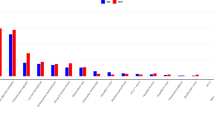Abstract
Purpose
The aim of this study was to determine the impact and outcome of consultations of HIV-infected women if a pregnancy is planned.
Methods
This study was performed retrospectively based on patient’s records of HIV-infected women with the desire to become pregnant between 2000 and 2008. Relevant data regarding HIV infection, obstetrical history, diagnostic procedures and medical interventions related to conception, as well as pregnancy outcomes, were evaluated.
Results
A total of 57 HIV-infected women (and their partner) were included; 38% (n = 22) of the couples showed a reduced fertility and 24 women (42%) became pregnant once or several times during the study period. Conception resulted from unprotected intercourse (n = 11), self-insemination (n = 10), assisted insemination (n = 2) or in vitro fertilization (n = 1). The outcome of all pregnancies was: 26 live births, 1 intrauterine fetal demise (38 weeks), 1 miscarriage, 1 cervical pregnancy and 1 legal abortion. No horizontal transmission occurred in serodiscordant couples. Seven (12%) women were lost to follow-up, 12 couples (21%) abandoned the attempt to get pregnant, and 14 couples (25%) reported an ongoing wish for a child.
Conclusions
In this group of HIV-affected couples, we showed a high rate of reduced fertility. In our study, consultations and interventions led to a pregnancy rate of 42% without horizontal transmission of HIV.

Similar content being viewed by others
References
UNAIDS Report 2009. http://data.unaids.org/pub/Report/2009/JC1700_Epi_Update_2009_en.pdf. Accessed 26 Nov 2009
Chen JL, Phillips KA, Kanouse DE, Collins RL, Miu A (2001) Fertility desires and intentions of HIV-positive men and women. Fam Plann Persp 33:144–152
Fiore S, Heard I, Thorne C, Savasi V, Coll O, Malyuta R, Niemiec T, Martinelli P, Tibaldi C, Newell ML (2008) Reproductive experience of HIV-infected women living in Europe. Hum Reprod 23:2140–2144
Warszawski J, Tubiana R, Le Chenadec J, Blanche S, Teglas JP, Dollfus C, Faye A, Burgard M, Rouzioux C, Mandelbrot L, ANRS French Perinatal Cohort (2008) Mother-to-child HIV transmission despite antiretroviral therapy in the ANRS French Perinatal Cohort. AIDS 22:289–299
The antiretroviral pregnancy registry. http://www.apregistry.com/. Accessed 1 Dec 2009
Coll O, Lopez M, Vidal R, Figueras F, Suy A, Hernandez S, Loncà M, Palacio M, Martinez E, Vernaeve V (2007) Fertility assessment in non-infertile HIV-infected women and their partners. Reprod Biomed Online 14:488–494
Kongnyuy EJ, Wiysonge CS (2008) Association between fertility and HIV status: what implications for HIV estimates? BMC Public Health 8:309
Ezeanochie M, Olagbuji B, Ande A, Oboro V (2009) Fertility preferences, condom use, and concerns among HIV-positive women in serodiscordant relationships in the era of antiretroviral therapy. Int J Gynaecol Obstet 107:97–98
Tandler-Schneider A, Sonnenberg-Schwan U, Gingelmaier A, Meurer A, Kremer H, Weigel M, Vernazza P, Schmied B, Klumb S, Schafberger A, Kupka M, Friese K, Brockmeyer NH (2008) Diagnostics and treatment of HIV-affected couples who wish to have children. Eur J Med Res 13:546–551
Vernazza P, Hirschel B, Bernasconi E, Flepp M (2008) HIV-infizierte Menschen ohne andere STD sind unter wirksamer antiretroviraler Therapie sexuell nicht infektiös. Schweizerische Ärztezeitung 89:165–169
Mugo NR, Kiehlbauch JA, Nguti R, Meier A, Gichuhi JW, Stamm WE, Cohen CR (2006) Effect of human immunodeficiency virus-1 infection on treatment outcome of acute salpingitis. Obstet Gynecol 107:807–812
Hinz S, McCormack D, van der Spuy ZM (2002) Endocrine function in HIV-infected women. Gynecol Endocrinol 16:33–38
Palefsky J (2009) Human papillomavirus-related disease in people with HIV. Curr Opin HIV AIDS 4:52–56
Okolo S (2008) Incidence, aetiology and epidemiology of uterine fibroids. Best Pract Res Clin Obstet Gynaecol 22:571–588
Kohler JJ, Lewis W (2007) A brief overview of mechanisms of mitochondrial toxicity from NRTIs. Environ Mol Mutagen 48:166–172
López S, Coll O, Durban M, Hernàndez S, Vidal R, Suy A, Morén C, Casademont J, Cardellach F, Mataró D, Miró O, Garrabou G (2008) Mitochondrial DNA depletion in oocytes of HIV-infected antiretroviral-treated infertile women. Antivir Ther 13:833–838
Shenfield F, Pennings G, Cohen J, Devroey P, Tarlatzis B, Sureau C, ESHRE ETHICS LAW Task Force (2004) Taskforce 8: ethics of medically assisted fertility treatment for HIV positive men and women. Hum Reprod 19:2454–2456
Gilling-Smith C, Nicopoullos J, Semprini A, Frodsham LC (2006) HIV and reproductive care: a review of current practice. BJOG 113:869–878
Cibulka NJ (2007) Conception practices of HIV-infected women in the Midwest. J Assoc Nurses AIDS Care 18:3–12
Barreiro P, del Romero J, Leal M, Hernando V, Asencio R, de Mendoza C, Ramos JT, González-Lahoz J, Soriano V, Spanish HIV-Discordant Study Group (2006) Natural pregnancies in HIV-serodiscordant couples receiving successful antiretroviral therapy. J Acquir Immune Defic Syndr 43:324–326
Quinn TC, Wawer MJ, Sewankambo N, Serwadda D, Wabwire-Mangen F, Meehan MO, Lutalo T, Gray RH (2000) Viral load and heterosexual transmission of human immunodeficiency virus type 1. N Engl J Med 342:921–929
Fiore JR, Suligoi B, Saracino A, DiStefano M, Bugarini R, Lepera A, Favia A, Monno L, Angarano G, Pastore G (2003) Correlates of HIV-1 shedding in cervicovaginal secretions and effects of antiretroviral therapies. AIDS 17:2169–2176
Okwundu CI, Okoromah CA (2009) Antiretroviral pre-exposure prophylaxis (PrEP) for preventing HIV in high-risk individuals. Cochrane Database Syst Rev 1:CD007189
Conflict of interest
We declare that we have no conflict of interest.
Author information
Authors and Affiliations
Corresponding author
Rights and permissions
About this article
Cite this article
Gingelmaier, A., Wiedenmann, K., Sovric, M. et al. Consultations of HIV-infected women who wish to become pregnant. Arch Gynecol Obstet 283, 893–898 (2011). https://doi.org/10.1007/s00404-010-1794-5
Received:
Accepted:
Published:
Issue Date:
DOI: https://doi.org/10.1007/s00404-010-1794-5




